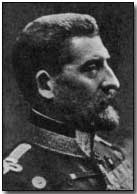Who's Who - King Ferdinand I
 King Ferdinand I of Romania
(1865-1927), having begun the war as a careful neutral, finally declared for
the Allies in August 1916.
King Ferdinand I of Romania
(1865-1927), having begun the war as a careful neutral, finally declared for
the Allies in August 1916.
Suffering prompt invasion by the Germans and exile to the north-east of the country, Ferdinand nevertheless emerged from the war victorious having succeeded in extracting notable territorial gains at the Paris Peace Conference in 1919.
Born on 24 August 1865 at Sigmaringen in Prussia, Ferdinand was the son of Prince Leopold of Hohenzollern (King Carol's brother). He arrived in Romania in 1884, returning shortly afterwards to Germany in order to resume his studies.
He graduated from the University of Lipsca in 1889, thereafter moving to Bucharest to fulfil his duties as heir to the Romanian throne.
Ferdinand married, on 10 January 1893, Princess Marie, daughter of the Duke of Edinburgh (and grand-daughter of Queen Victoria). This British connection helped temper his ties with Austria-Germany; aside from his German relations he was a close friend of the Austro-German Emperor, Franz-Josef.
Succeeding Carol as King in October 1914, Ferdinand found his belief in Germanic strength put to the test by the realities of the European war underway. Wife his pro-Allied wife, and his equally pro-Allied Prime Minister Ion Bratianu, Ferdinand came to agree with the latter's policy of wait-and-see. Bratianu was in favour of entering the war with the Allies when the time was most ripe.
Unfortunately that time almost certainly wasn't August 1916. Having finally cast his lot with the Allied cause (and being disowned by his German relations) and having witnessed the impressive Russian Brusilov offensive, Romania found herself rapidly invaded and occupied by not one but two German armies. Bucharest fell on 6 December 1916.
In many ways Romania's declaration of support for the Allies proved counter-productive. Not only were Allied resources tied up in defence of the Romanians, but Germany's ruthless exploitation of Romania's natural resources manifestly aided the German army elsewhere for as much as two years.
Finding his support falling in the wake of such rapid defeat, and with the remnants of the Romanian army in full retreat to the north-east of the country, Ferdinand found that he could only maintain interest in army recruitment by promises of social and constitutional reform following the war.
With the collapse of Russia at the close of 1917 Ferdinand realised the urgency of seeking a settlement with the Central Powers. With an armistice agreed on 9 December 1917, German exasperation at Ferdinand's reluctance to agree actual peace terms (which were in any event humiliating to Romania) prompted Germany to overrun the country in March 1918.
Romania having apparently accepted the terms of the peace, Ferdinand nevertheless refused to afford the Treaty of Bucharest of May 1918 his signature. This proved most convenient when, on 10 November, with Germany collapsing, it gave Ferdinand an excuse to re-enter the war with the Allies. An astute if cynical move it paid off in terms of territorial gains achieved at the Paris Peace Conference the following year.
Ferdinand re-entered Bucharest on 1 December 1918 and was crowned King of Greater Romania in 1922. He was chiefly notable thereafter for conspicuously evading his earlier promises of social and constitutional reform, although he achieved a reputation as 'King of the Peasants' for his efforts towards land reform in 1921.
In 1925 he was obliged to force his son, Crown Prince Carol, to renounce his rights of succession on account of the latter's playboy lifestyle. He specified in his will the succession of his young grandson, Prince Michael.
King Ferdinand I died on 20 July 1927 at the age of 61.
Click here to read King Ferdinand's proclamation to the Romanian people on the day war was officially announced; click here to read his proclamation to the Romanian Army issued the same day.
A 'Tour' was a period of front-line service.
- Did you know?
